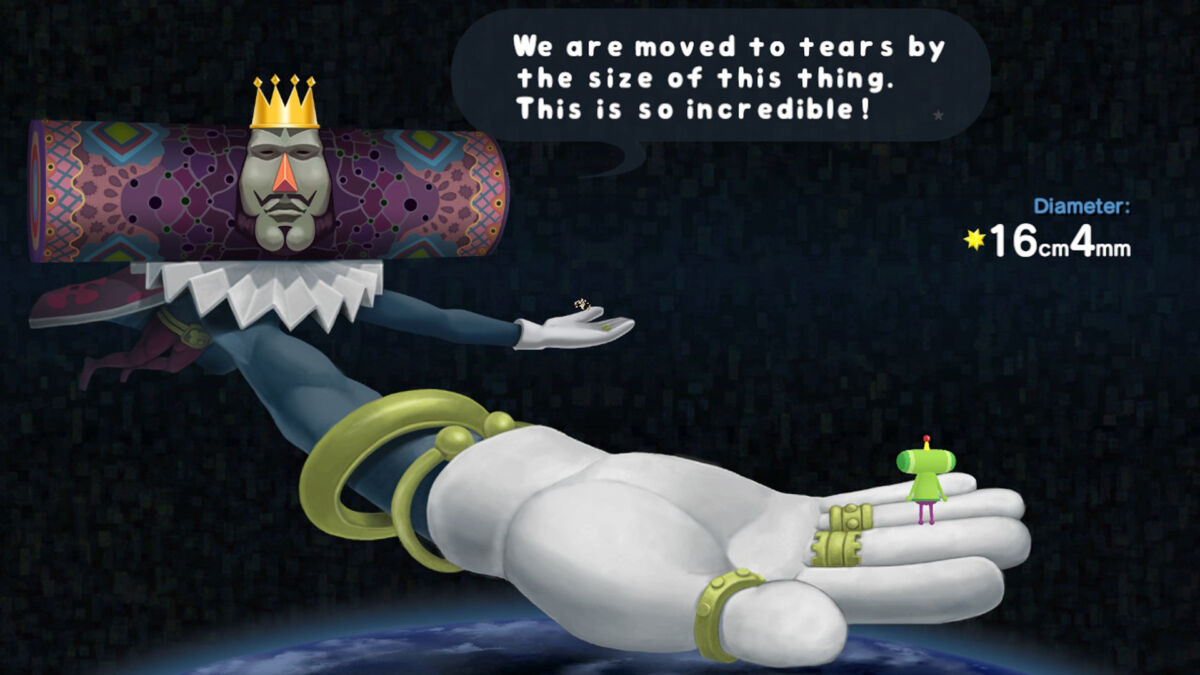“What is this game? And what is it so excited about, anyway?”.
These were just some of the gaming industry’s biggest questions when, in 2004, an overstimulated game by the name of “Katamari Damacy” rolled (don’t count ‘em, your head will hurt) into this cluttered mess of a world. It seemed like it came out of nowhere, like a punchline expecting no setup from anyone but itself, singing an honest love song to whomever the lucky recipients were. The tune felt familiar. Like a reminder.
But like most things that leave big impressions, our answers then were mostly a series of isolating, if well-intentioned, labels.
“Bizarre”. “Creative”. “Feverish”. “Odd”. Strange”. “Unique”. “Uncommon”.
“Weird”.
In 2023, our consensus is, fortunately, better — that Katamari Damacy is one of the most exuberant, caring, and celebratory epics the video game industry has ever produced. A work so individual in its design that even today, its sensibilities are present all around us, within counties full of donut-sized holes and indie developers carrying its design ethos with pride. The game has garnered its place among video games’ brightest stars.
But with over two decades of gaming hindsight and planet-shattering anxieties in our minds, it still feels like the game has much more to say. After playing it myself, looking for laughs and escapism, I realized that the reason Katamari Damacy still rolls freely in our collective memory is because it’s a work of genuine love towards ourselves. Unironic to the core. Happy to repeat its prideful labels if we could just truly listen to what it has to say.
As most fans already know, “katamari” means clod, or clump in Japanese, while “damacy” is a morphological paraphrasing of sorts from a word that means spirit, or soul. The title, like most things in this game, proposes that despite not being such a thing as a “cluttered self”, there is, in fact, such a thing as a small one.
A Star Is Rolled

The story, like most things in Katamari Damacy, is sensical enough to feel reasonable. One day, The King of All Cosmos, a passive-aggressive icon of a god, accidentally destroyed all of the stars in our galaxy in a drunkard ecstasy, which led him to send the Prince, his adorable 2-inch son who’s just trying his best, to collect absolutely everything he finds on Earth so he can turn it into stars with the help of a katamari, a super-adhesive magic ball that can roll pretty much everything smaller than itself.
The actual game, unlike its attention-starved god, isn’t narcissistic. As unconventional as the premise is, your narrative and mechanical goal is simple: to use your sticky ball everywhere you go to collect, well, literally everything. What this means in the moment-to-moment gameplay is that mechanics, control schemes, and progression are so entwined as to be practically the same thing. You look for stuff to roll, but you stomp yourself with big things, so you roll the small stuff, then the bigger things, on and on, for as long as God’s “faith in you” timer says so. It’s simple. Graceful. Pretty funny.
Never repetitive, though. As Tim Rogers puts it, each level has this “new snow feeling,” that of a familiar thing filled with new, endless ways to stick them to you every time you start, alongside the dozens of little vibrations and eccentric sounds the game rewards you with to validate each attempt. It’s incredibly satisfying, generous in a tremendously replayable way, and engaging to the point of giving a uniquely zen quality to its excitement, especially with the timer pushing you forward to never become too complacent with your progress. The perfect spot to soak in all of the textures and melodies of its personality.
Gin & Tonic & Red Red Roses

If you only need 5 seconds to understand Katamari Damacy’s gameplay, you don’t even need 3 for the initial cutscene to make you reel back in awe — singing ducks, dancing cows, deities with colorful hammers for heads, little girls that can feel the cosmos through your newly formed constellations, all punctuated by a “plot” that’s just an increasingly complex non-sequitur about a Minecraft-looking family with voices so detached they could kill Brecht without even trying.
This is the heart of Katamari Damacy — an attitude of authentic, child-like enthusiasm in itself and the planet it belongs to. It’s what makes the free-association quality of its presentation cohesive, its eccentricities honest. That’s why calling it a satire or cosmic horror or “weird” will always come off as reductive; it’s too ridiculous to be actually cynical, too surreal to give a lecture of any kind, and ultimately, too engaged with the world it’s riffing to ever, ever downplay it. It presents, in short, a place brimming with shiny, lively, mostly unnecessary, always familiar stuff. Our stuff.
Music and sound design, maybe more than any other aspect of the game, are the magic glue that holds and expands on everything it has to offer. It immediately enhances every facet of its aesthetics vibrantly. So much so that, for lots of people, Katamari and its sounds are the same thing. It’s nostalgic and epic, funny and beautiful, calming and exhilarating, all at once and then some.
Most contemporary AAA games invest millions in trendy aesthetics or “serious” vibes to show themselves as marketable and respectable, with “lots of stuff to say” as long as the investors like what’s been said. Katamari Damacy, on the other hand, is confident enough in itself to state that yes, a post-modern mambo brimming with sexual innuendos is exactly the vibe you need to roll up every crab you can find, your smallness.
My, Earth really is full of things…
I always appreciated this game from a distance. Then I saw a great playthrough and got ridiculously obsessed with the soundtrack to the point of getting some tracks as alarm songs (not recommended). Then I played it, quite recently in fact, just because I wanted to escape from whatever the world is right now, saying to myself I didn’t have to look around for a game to say something important to me.
And then, after playing for a couple of hours, I found my answer in the form of an uncomfortable reminder. A news article stated how at the beginning of 2016, a country’s government began strictly banning local architecture because they deemed it as ugly, bizarre.
“Weird”. This was the label they used the most. Still is. Whatever its reasons were, they never elaborated on what these labels meant.
From any news as tame-looking as this, it’s extremely simple to cascade downwards to the actually grim stuff. You know — humanitarian crises, xenophobia, corruption, disparity, the like. Take the main tune, change the instrumentation, and almost everyone will tell you horror stories in different variations (even privileged folk can’t cover their ears as well as they used to, and I say that from experience). Yet, as loud as this generation is about identity non-conformity and systematic oppression, even when trying to help from wherever we can, it’s never been easier to just “other” everything out, and isolate ourselves.
Kinder, braver people than me have taught me a unique riff of this tune, though — that to unstick ourselves from this world, is to unmake ourselves. That the only attitude that can make us whole, especially in these times of sorrow, is the one of throwing ourselves toward wherever our lives roll us until a bigger impression of ourselves, a stronger appreciation, and an uncompromising understanding of our personal and general reality starts to form. That as justified as the anger may be, to condemn this world of not having anything joyful or dignified anymore isn’t just solipsistic, but also the dullest form of defeatism. That there isn’t any shame, nor should it be, on whatever we gathered because, well, that’s us.
I played Katamari Damacy for escapism. I ended up with reality staring me right in the face. Again. Funny how a 19-year-old game can, if you will, make you roll everything together. God bless it.
Lonely rolling stars or however the hell we feel like these days, we’ll always be everything and everyone that has stuck in our way. As entitled as we are to ourselves, so is our reality, for better and worse. So no, we don’t need to struggle with “how to feel” with our world — we just have to be angry. Be sad. Be attentive. Be humble. Be generous. Be vigilant. Be loud. Be comprehensive. To be whatever we feel like being, then some, as long as we don’t ignore it.
Most importantly, as the most genuine people in my life and the most genuine game I’ve ever played have been singing from the very beginning — we just have to be whatever the hell we’ve always been, as long as we keep clinging however we can to this cluttered, anxious, bizarre, creative, feverish, odd, strange, uncommon, unique, and weird home of ours.
READ NEXT: Ranking Every Spider-Man Game From Worst To Best
Some of the coverage you find on Cultured Vultures contains affiliate links, which provide us with small commissions based on purchases made from visiting our site.

